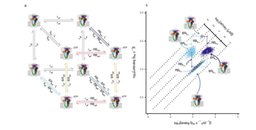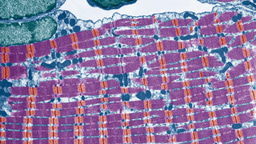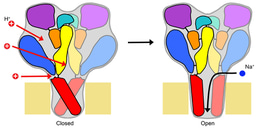Negative cooperativity controls Actin Polymerases
Published in Cell & Molecular Biology

This mode of regulation had been suggested for only a few metabolic enzymes, however, it was not clear why decreasing the sensitivity of a response to a signal was important.
In the work published in Communication Biology https://rdcu.be/em0vB, a thermodynamic analysis of the linkage between heterotropic ligand binding to Diaphanous 1 (DIAPH1), a Diaphanous Related Formin (DRF) is presented. DIAPH1 is an actin polymerase, which is autoinhibited by intramolecular interactions between its N-terminal domain DID and C-terminal domain, DAD. DIAPH1 becomes active when a small GTPAse, RhoA, binds to the N-terminus region of DIAPH1 that includes DID and breaks the autoinhibitory interaction. We were trying to rationalize an observation made by previous investigators and, in particular, Bruce Goode’s lab, https://pmc.ncbi.nlm.nih.gov/articles/PMC3416746/, that micromolar concentration of RhoA is required for DIAPH1 activation in spite of the fact that RhoA binds to the N-terminal region with nanomolar affinity.
Using high resolution NMR spectroscopy, my graduate student, Greg Theophall, made a critical observation that both RhoA and DAD can simultaneously bind to the N-terminal region rejecting previous assumption that DIAPH1 regulation is due to the direct displacement of DAD by RhoA. Further analysis enabled us to propose a model that utilizes negative cooperativity as a key element in regulating Diaphanous 1 activity that can also be extended to include all DRFs. By exploiting negative cooperativity, DRFs maintain a reserve of inactivated DIAPH1 for other cellular processes. And unlike the sharp, switch-like functional transitions that accompany small changes in ligand concentration in allosteric systems that make use of positive cooperative binding, negative binding cooperativity in DRFs enables more gradual responses to cellular processes that require prolonged and sustained regulation, such as cell migration, phagocytosis, and cytokinesis.
Follow the Topic
-
Communications Biology

An open access journal from Nature Portfolio publishing high-quality research, reviews and commentary in all areas of the biological sciences, representing significant advances and bringing new biological insight to a specialized area of research.
Your space to connect: The Myeloid cell function and dysfunction Hub
A new Communities’ space to connect, collaborate, and explore research on Clinical Medicine and Cell Biology!
Continue reading announcementRelated Collections
With Collections, you can get published faster and increase your visibility.
Cancer Cell Atlases
Publishing Model: Open Access
Deadline: Jan 15, 2026
Lipids in Cell Biology
Publishing Model: Open Access
Deadline: Mar 03, 2026



